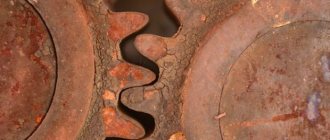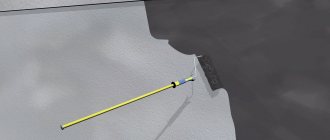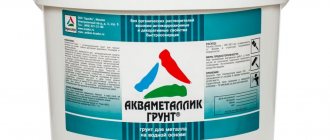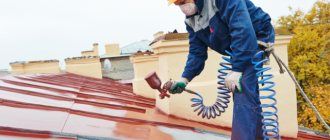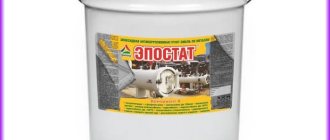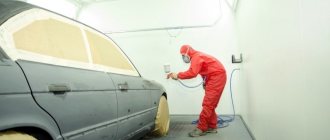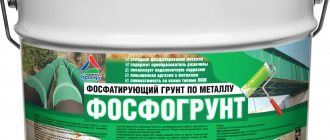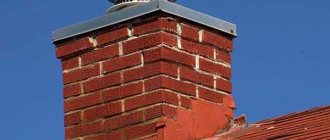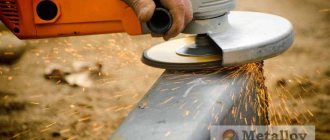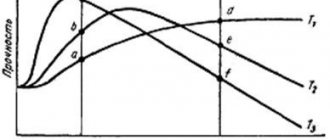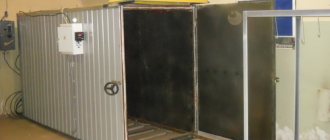9544 0 6
Maksym June 26, 2017 Specialization: country construction, apartment renovation, landscaping of a personal plot, installation and connection of utilities.
Any paint will work well on zinc primer.
Do you want to protect your metal from corrosion for a long time? To do this, before painting, you need to apply a zinc-containing primer to the surface. I will describe several types of anti-corrosion primer and tell you how to use them correctly for painting metal.
Soil composition
Zinc-containing soil is up to 99% zinc in the form of dust or flakes. Depending on the other components in the composition, the material is divided into 2 types:
- Soils containing zinc and organic matter. These are film formers (epoxy or polyurethane). Such compositions make it possible to create high electrical conductivity, providing protective protection through metal polarization. This process of electrochemical protection for metal is a fundamental factor.
- Zinc-containing inorganic soils. They include high dielectrics (ethyl silicates), liquid glass (alkali silicates) and amorphous polymers (polyvinyl butyrals).
There are combined and bimetallic primers. Along with zinc, aluminum, magnesium, and red lead can be added to the composition. They use alkali-resistant materials such as polystyrene, chlorinated rubber, and polyvinyl resins as film-forming components.
What is cold galvanizing
Galvanizing of metal can be carried out in two ways - hot and cold. The first option uses special equipment, and for the second you need to buy paint with zinc in the composition. However, this practically does not affect the quality of the metal product. The cold galvanizing method involves coating the metal with a special agent to protect it from corrosion. Zinc paint contains special elements that prevent the metal from deteriorating over time. The cold galvanizing method has practically no special features. Zinc-containing paint is applied to the surface like a regular dye, evenly distributed over the base.
Metal galvanization and its advantages
After painting, the galvanized structure is protected not only from mechanical damage. It also takes on an unusual glossy color. There are other positive aspects of galvanizing surfaces:
- quick drying;
- prevents corrosion;
- prevents rust formation;
- if the coating is damaged, it can be restored;
- A solvent can be used for processing.
Galvanizing is quite simple, but after the manipulations, the surface looks neat and is protected from mechanical damage and damage.
Application area of cold galvanizing
You can galvanize coatings yourself at home, but the product is also often used on an industrial scale for metal processing. Most often, the method is used for the following purposes:
- Foundation for bridges.
- Building construction.
- Ships.
- Pipes.
- Tunnels.
- Port designs.
- Metal pillars.
You can use a zinc-based product for almost any metal coating; it will not spoil them, but rather will create an additional protective layer to prevent corrosion.
Advantages and disadvantages
The long process of application by consumers made it possible to highlight a sufficient number of points in favor of zinc-containing soils:
- they are applicable in any climatic conditions (high humidity or low temperatures);
- durable (have a service life of 15 to 50 years);
- waterproof and resistant to mechanical stress;
- inert to almost all types of chemicals;
- have a high level of anti-corrosion protection;
- heat-resistant and fire-resistant;
- increase the adhesion of the base and topcoat.
- are plastic and do not delaminate.
The main disadvantages of zinc-containing soil are:
- high toxicity;
- insufficient adhesion with finishing coatings;
- reduced electrical conductivity, which affects anti-corrosion protection.
Characteristics and properties
An important point in the characteristics of zinc soils is the percentage composition of zinc content. But why did manufacturers choose zinc? The answer to this question lies in the properties of the metal itself. Zinc melts at a temperature of 419.5°C, quite low for metals, and at 200°C it becomes very brittle, which allows it to be crushed to dust. This metal is also used in the production of negative electrodes and can be 100% reused.
During long-term testing, it was found that the optimal value is 75.4% zinc in the form of dust. But manufacturers did not stop there and continued to reduce the figure. This is how they discovered a recipe for combining round and plate-shaped zinc particles. This made it possible to reduce the percentage of metal content to 30%.
This was explained by the fact that a large number of round particles react with each other individually, while particles of several shapes complement each other and show “cooperation” in protection. Another positive result was an increase in the protective anti-corrosion effect, which additionally arises due to the gate structure of zinc.
The flake-like form of zinc-containing primer also reduces the number of pores on the metal surface, which prevents the occurrence of white corrosion and destruction of the material.
Thus, it was revealed that highly filled zinc-containing primers for metal are inferior in characteristics to low-filled ones. In addition, the use of zinc flakes in the formulation of protective primers is economically justified, since the cost of zinc is higher than the price of many used film formers.
On video: zinc spray.
Liquid zinc in aerosol
Liquid zinc in an aerosol is very convenient for self-priming a car part being restored; in any case, reviews of zinc in cans indicate that such an anti-corrosion primer is very popular.
Manufacturers of car paints offer a very wide choice of zinc in spray: Wurth zinc, Berner zinc spray, ZINTEC® zinc-containing primer for cars, Newton zinc primer, reviews from owners of a wide variety of car brands. On our website we suggest that you familiarize yourself with the characteristics of the Professional zinc spray can 520ml produced by Thunder Paint. And if the restoration is subject to very minor damage to the paintwork (chip, scratch), then on the Autocolor7.com website you can choose a restoration pencil with zinc with a capacity of 15 or 30 ml.
Return
Scope of application
Zinc primers for metal are quite widely used to protect industrial and building structures, such as overpasses and bridges. In the oil and gas industry, zinc-based soils are used to treat tanks, pipes, oil pipelines, storage facilities, and pumping equipment. In shipbuilding, such compositions are used for anti-corrosion treatment of platforms, sea and river vessels, and various metal structures.
Converters and tread primers are widely used in automotive production. Protective primers with zinc are used to cover metals subject to the process of electric arc and spot welding.
The protective function of zinc primer for metal can be explained by the structure of the composition, which is highly dispersed. In contact with moisture and air, zinc oxidizes, attracting the negative effects of the environment, thereby distracting metal surfaces from destruction.
Material containing zinc is “cemented” by oxidation products and creates a protective layer - a film that serves as an impenetrable barrier to moisture.
Purpose and use of zinc-rich primer
To reliably protect metal structures from corrosion, a primer with zinc is used for metal. With the help of this substance, a protective layer is created that is durable and reliable, thanks to which moisture does not penetrate the coating. For this reason, iron does not undergo the corrosion process.
How to use
You can achieve optimal metal preservation by taking all measures to protect it:
- First of all, you need to wisely choose a zinc-containing primer, in accordance with your operating conditions and requirements. Currently, there are many types of primers for metal, so consultation with a specialist is necessary.
- Before applying the primer, thoroughly clean the surface from old coating, dirt and rust, degrease, and dry. It is advisable to use different types of cleaning.
- Choose your application method: brush, roller, pneumatic or airless.
- Before use, the primer should be shaken thoroughly to achieve a uniform composition.
- The mixture should be applied in at least 2 layers, with drying time in between. At a temperature of 20°C, the coating dries in about an hour.
It is important to know that zinc primer is applied in the range from +5 to +40°C. It is also worth considering that not all paints are suitable for coating zinc-containing primer.
Review of zinc-containing primers (3 videos)
Products from different manufacturers (25 photos)
What is the difference between acid primer and epoxy primer?
Epoxy primer is a substance that includes epoxy resin, fillers, polymers, and some alcohol derivatives. The primer, after application, creates a film that does not allow oxygen to pass through. After hardening, the soil does not allow water to penetrate at all, since it does not form pores. Epoxy primer is available in a can or in jars.
Epoxy primer in cansSource sevparitet.ru
Epoxy Primer Differences
Epoxy primer should be applied, according to experts, directly to clean metal, and then putty
This is especially important if the metal is being restored over several weeks, i.e.
for a long time.
For example, if a car sits in a garage for a long time, then, since there is humidity in the room, the areas of the body that have been stripped down to metal will begin to oxidize. In this case, you can choose the option of puttying with an epoxy primer. Then the putty should be applied before the primer has completely hardened.
Differences in acid soil
When it comes to acidic soil, you can hear the following names: phosphating, etching, reactive. The primer in this embodiment is a compound of zinc and phosphoric acid. More precisely, it consists of:
- polyvinyl butyral, which is a synthetic material and serves to form good adhesion and film;
- zinc phosphates and chromates;
- water;
- phosphoric acid, which is an excellent rust converter;
- alcohol.
Composition of acid soilSource strport.ru
The principle of operation is approximately this: phosphoric acid acts on the metal and, at the same time, zinc is precipitated. The film is formed by polyvinyl butyral - the acrylic layer will already adhere tightly to it. After applying the primer to the metal surface, a thin coating is obtained. It is an anti-corrosion and adhesive layer. The primer does not completely destroy the rust that is already there, but it also does not allow it to spread.
Acid primer for cars is divided into four main types:
One-component.
If you purchase a two-component primer, you must prepare a primer. To do this, it is mixed with an activator, and the consistency can be different - hard or soft.
Two-component primer Source autocosmetica.by
Professionals prefer to work with a solid form, as it gives the strongest film. Depending on the recommendations in the instructions, the two-component composition can be applied in 1, 2, 3 layers. During treatment, maintain an interval of approximately 5 minutes between applications.
Reactive.
This option is used for clean surfaces. The reactive substance forms a very small layer (8-13 microns). This is the base on which the following layers should be applied.
This substance is a soil with the addition of zinc. Used to eliminate unevenness and improve the quality of adhesion. The substance acts on the metal, resulting in the creation of a layer of frozen polymer elements.
You can choose a one- or two-component primer, but most craftsmen use a material that has two ingredients. The greatest wear resistance is achieved through filler primer - this is a necessary stage of coating.
